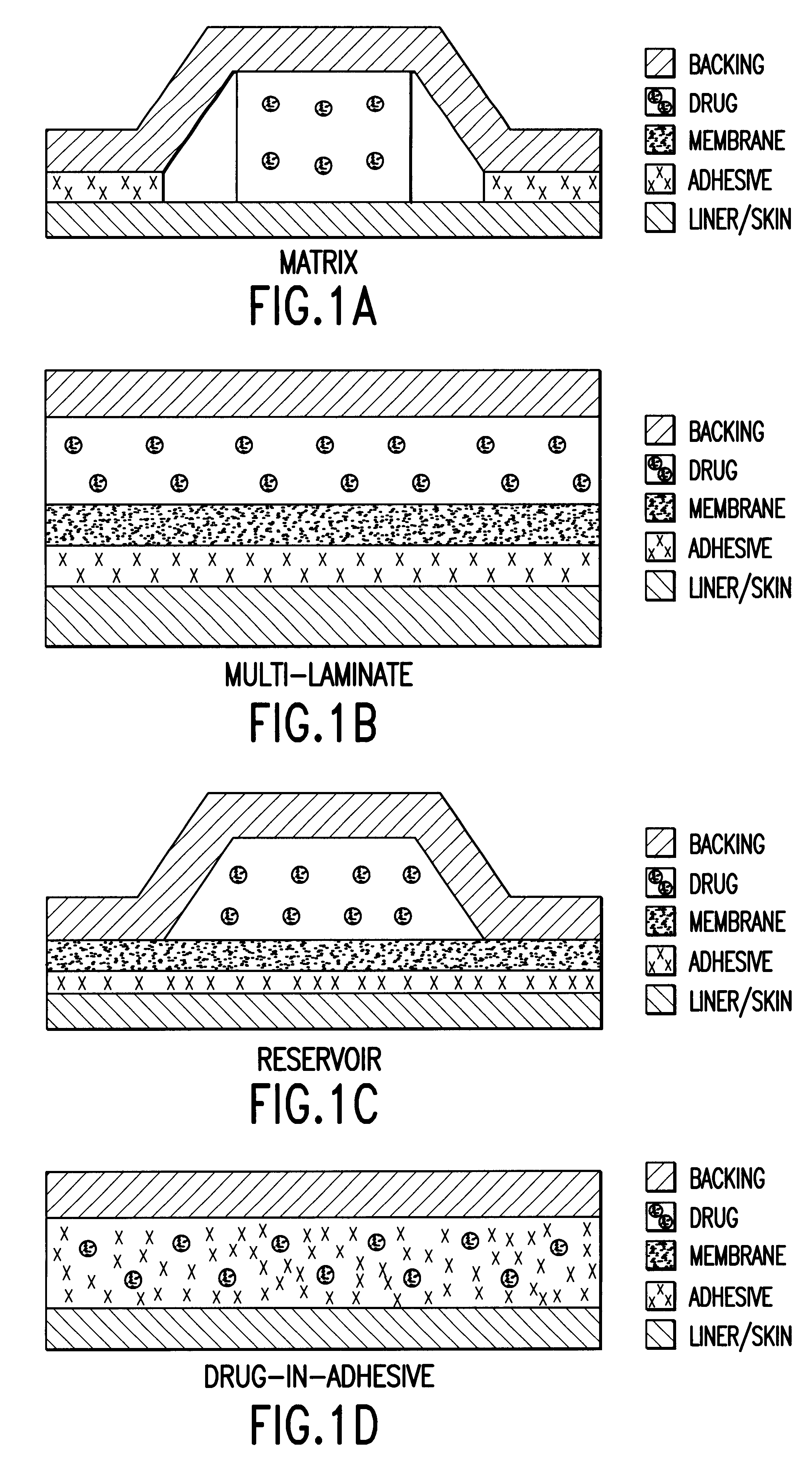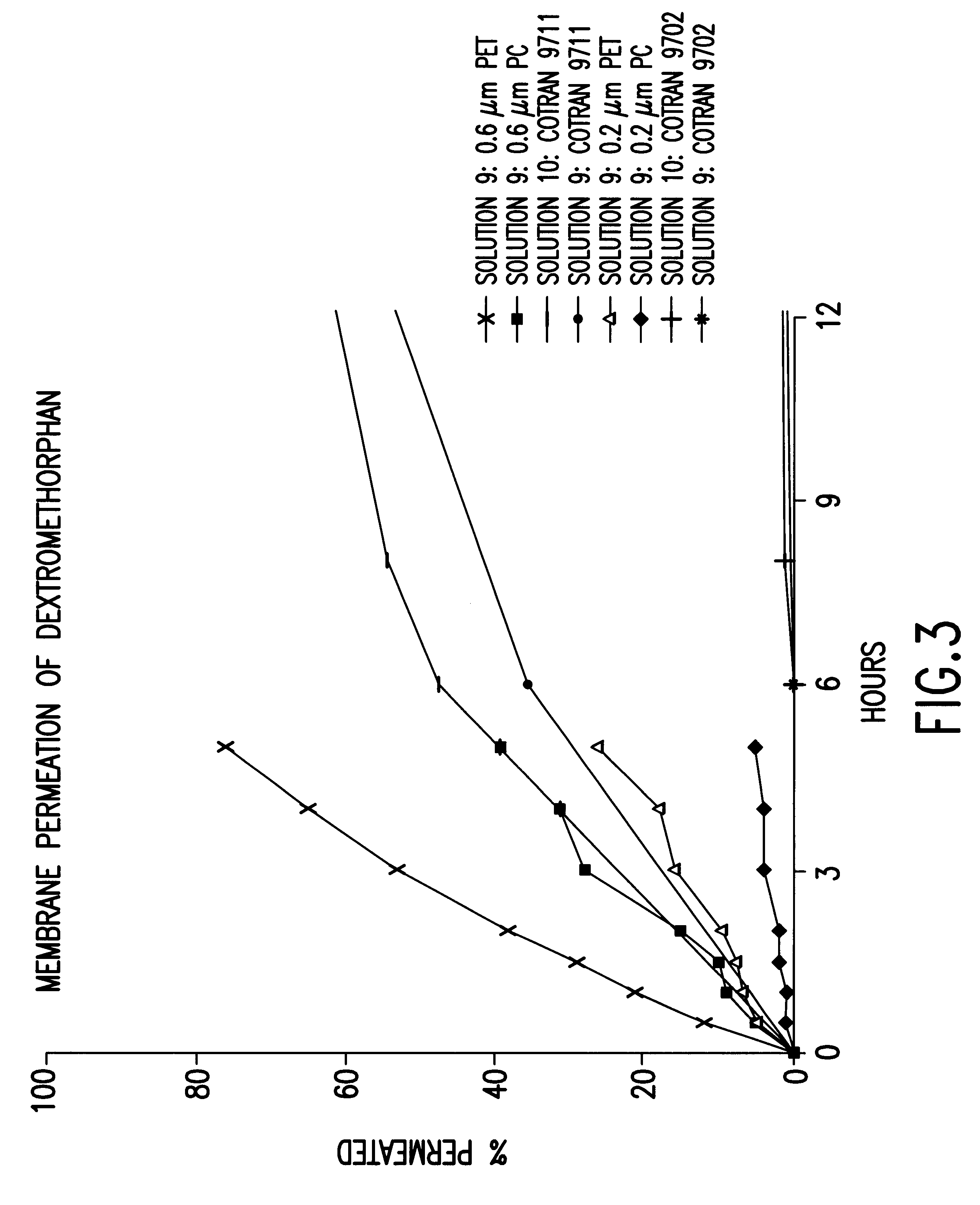Transdermally administered dextromethorphan as antitussive agent
a technology of dextromethorphan and transdermal administration, which is applied in the direction of biocide, drug composition, bandages, etc., can solve the problems of not showing that this is possible with said devices, and non-useful devices for administering dextromethorphan
- Summary
- Abstract
- Description
- Claims
- Application Information
AI Technical Summary
Benefits of technology
Problems solved by technology
Method used
Image
Examples
example 2
Analysis of the receptor solutions described in Examples 3 and 4.
Quantitative determination of dextromethorphan in the receptor solution samples from the skin permeation studies in Example 3 and from the membrane permeation studies in Example 4 was done by the HPLC method described under Apparatus.
example 3
In vitro skin permeation studies from solutions of dextromethorphan.
Solution 1
A saturated dextromethorphan solution in demineralized water.
Solution 2
A saturated dextromethorphan solution in demineralized water containing 10 mg / ml of b-cyclodextrine.
Solution 3
A saturated dextromethorphan solution in demineralized water containing 10 mg / ml of hydroxypropyl-b-cyclodextrine.
Solution 4
50 mg dextromethorphan was dissolved in 5 ml isopropyl myristate.
Solution 5
50 mg dextromethorphan was dissolved in 5 ml propylene glycol.
Solution 6
50 mg dextromethorphan was dissolved in 5 ml propylene glycol containing 50 mg / ml of azone.
Solution 7
250 mg dextromethorphan was dissolved in 5 ml ethanol.
Solution 8
150 mg dextromethorphan was dissolved in 5 ml ethyl acetate.
In vitro permeation of dextromethorphan from the solutions 1, 2, 3, 4, 5, 6, 7 and 8 through dermatomed pig skin was investigated in Franz diffusion Cells.
Skin pieces with a thickness of approximately 765 .mu.m were dermatomed from full thick...
example 4
In vitro permeation studies across artificial membranes from solutions of dextromethorphan, imitating the reservoir type transdermal device.
Solution 9
50 mg dextromethorphan was dissolved in 5 ml propylene glycol.
Solution 10
50 mg dextromethorphan was dissolved in 5 ml ethanol.
In vitro permeation of dextromethorphan from the solutions 9 and 10 across 6 different types of artificial membranes was investigated in Franz diffusion cells.
Artificial membranes of the following types were studied: Whatman 0.2 .mu.m PC (polycarbonate), Whatman 0.6 .mu.m PC (polycarbonate), Whatman 0.2 .mu.m PET (polyester), Whatman 0.6 .mu.m PET (polyester), Cotran 9702 (ethylene vinyl acetate film) and Cotran 9711 (microporous polyethylene film). The membranes were mounted in glass diffusion cells with an available diffusion area of 1.8 cm.sup.2. Solution 9 was applied on the surface of all the above membranes while solution 10 only was applied on Cotran 9702 and Cotran 9711. The opposite sides of the membran...
PUM
| Property | Measurement | Unit |
|---|---|---|
| Time | aaaaa | aaaaa |
| Time | aaaaa | aaaaa |
| Time | aaaaa | aaaaa |
Abstract
Description
Claims
Application Information
 Login to View More
Login to View More - R&D
- Intellectual Property
- Life Sciences
- Materials
- Tech Scout
- Unparalleled Data Quality
- Higher Quality Content
- 60% Fewer Hallucinations
Browse by: Latest US Patents, China's latest patents, Technical Efficacy Thesaurus, Application Domain, Technology Topic, Popular Technical Reports.
© 2025 PatSnap. All rights reserved.Legal|Privacy policy|Modern Slavery Act Transparency Statement|Sitemap|About US| Contact US: help@patsnap.com



